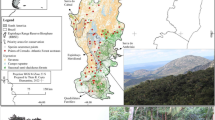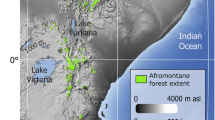Abstract
During Paleogene the Neotropical region was mainly covered by rainforests and ancient Amazon (AM) and Atlantic Forest (AF) were continuous and interconnected. The Andean uplift and drastic climate changes along the Eocene/Miocene resulted in the formation of a drier area separating AM from AF. However, multiple evidences have indicated recurrent connections between Neotropical rainforests during Quaternary. In this study we predict biogeographical connections between Neotropical Forests during the last glacial maximum (LGM—21 ka) and establish the climatic conditions that favored such connections. We tested if the general climatic conditions suitable to both Amazon (AM) and AF were uniform across current Cerrado and Caatinga areas or did subsets of these climatic spaces have independent spatial displacements connecting specific regions of AM and AF. For these, 50 occurrence points equidistant in the climatic space were sampled along the western and eastern AM and northern and southern AF and used to built ecological niche models (ENM) for each region. Potential distributions were predicted for the current and the LGM climatic scenarios using an ensemble approach. The ENMs detected the disjunct distribution of the two Neotropical rainforests in the present and showed three main connections during LGM: (1) climate suitable to western AM were detected along the northern coast of Brazil, overlapping the putative distribution of northern AF; (2) climates suitable to southern AF, northern AF and western AM were detected along the area now occupied by southern limits of the Caatinga and (3) the climate suitable to southern AF was found at the south limits of the eastern AM. Our findings suggest that subsets of both AM and AF may be considered distinct biogeographical units as implied by different responses to climate changes.





Similar content being viewed by others
References
Ab’Saber NA (1977) Os domínios morfoclimáticos da América do Sul. Primeira aproximação. Geomorfologia 53:1–23
Allouche O, Tsoar A, Kadmon R (2006) Assessing the accuracy of species distribution models: prevalence, kappa and the true skill statistic (TSS). J Appl Ecol 43:1223–1232
Auler AS, Smart PL (2001) Late quaternary paleoclimate in semiarid Northeastern Brazil from U-series dating of travertine and water-table speleothems. Quat Res 55:159–167
Auler AS, Wang X, Edwards RL et al (2004) Quaternary ecological and geomorphic changes associated with rainfall events in presently semi-arid northeastern Brazil. J Quat Sci 19:693–701
Barry S, Elith J (2006) Error and uncertainty in habitat models. J Appl Ecol 43:413–423
Batalha-Filho H, Fjeldså J, Fabre PH et al (2013) Connections between the Atlantic and the Amazonian forest avifaunas represent distinct historical events. J Ornit 154:41–50
Behling H, Arz HW, Pätzold J et al (2000) Late Quaternary vegetational and climate dynamics in northeastern Brazil, inferences from marine core GeoB 3104-1. Quat Sci Rev 19:981–994
Bigarella JJ, Andrade-Lima D, Riehs PJ (1975) Considerações a respeito das mudanças paleoambientais na distribuição de algumas espécies vegetais e animais no Brasil. An Ac Bras Cien 47:411–464
Broennimann O, Fitzpatrick MC, Pearman PB et al (2012) Measuring ecological niche overlap from occurrence and spatial environmental data. Glob Ecol Biogeogr 21:481–497
Carnaval AC, Moritz C (2008) Historical climate modelling predicts patterns of current biodiversity in the Brazilian Atlantic forest. J Biogeogr 35:1187–1201
Carnaval AC, Waltari E, Rodrigues MT et al (2014) Prediction of phylogeographic endemism in an environmentally complex biome. Proc R Soc Lond B 281:20141461
Carpenter G, Gillison AN, Winter J (1993) DOMAIN: a flexible modeling procedure for mapping potential distributions of animals and plants. Biodivers Conserv 2:667–680
Cheng H, Sinha A, Cruz FW et al (2013) Climate change patterns in Amazonia and biodiversity. Nat Commun 4:1411
Coimbra-Filho AF, Câmara, IG (1996) Os limites originais do bioma Mata Atlântica na Região do Nordeste do Brasil. FBCN
Costa LP (2003) The historical bridge between the Amazon and the Atlantic Forest of Brazil: a study of molecular phylogeography with small mammals. J Biogeogr 30:71–86
Cruz FW, Burns SJ, Karmann I et al (2005) Isolation-driven changes in atmospheric circulation over the past 116000 years in subtropical Brazil. Nature 434:63–66
Cruz FW, Vuille M, Burns SJ et al (2009) Orbitally driven east-west antiphasing of South American precipitation. Nat Geosci 2:210–214
De Oliveira PE, Barreto AMF, Suguiu K (1999) Late Pleistocene/Holocene climatic and vegetational history of the Brazilian caatinga: the fossil dunes of the middle São Francisco River. Palaeogeogr Palaeoclimatol Palaeoecol 152:319–337
Diniz-Filho JAF, Bini ML, Rangel TF et al (2009) Partitioning and mapping uncertainties in ensembles of forecasts of species turnover under climate change. Ecography 32:897–906
Farber O, Kadmon R (2003) Assessment of alternative approaches for bioclimatic modeling with special emphasis on the Mahalanobis distance. Ecol Mod 160:115–130
Fiaschii P, Pirani JR (2009) Review of plant biogeographic studies in Brazil. J Syst Evol 47:477–496
Fouquet A, Recoder R, Teixeira MJ et al (2012a) Molecular phylogeny and morphometric analyses reveal deep divergence between Amazonia and Atlantic Forest species of Dendrophryniscus. Mol Phylogenet Evol 62:826–838
Fouquet A, Loebmann D, Castroviejo-Fisher S et al (2012b) From Amazonia to the Atlantic forest: molecular phylogeny of Phyzelaphryninae frogs reveals unexpected diversity and a striking biogeographic pattern emphasizing conservation challenges. Mol Phylogenet Evol 65:547–556
Fouquet A, Cassini CS, Haddad CFB et al (2014) Species delimitation, patterns of diversification and historical biogeography of the Neotropical frog genus Adenomera (Anura, Leptodactylidae). J Biogeogr 41:855–870
Hanagarth W (1993) Acerca de la geoecologia de las sabanas del Benien el noreste de Bolivia. Instituto de Ecología, La Paz
Hoorn C, Wesselingh FP, Ter-Steege H et al (2010) Amazonia through time: Andean uplift, climate change, landscape evolution, and biodiversity. Science 330:927–931
Jiménez-Valverde A, Peterson AT, Soberón J et al (2011) Use of niche models in invasive species risk assessments. Biol Invasions 13:2785–2797
Lima-Ribeiro MS, Varela S, González-Hernández J et al (2014) The EcoClimate Database, http://ecoclimate.org, Accessed on Aug 30
Lisiecki LE, Raymo ME (2005) A pliocene-pleistocene stack of 57 globally distributed benthic d18O records. Paleoceanograph 20:PA1003. doi:10.1029/2004PA001071
Martini AMZ, Fiaschi P, Amorim AM et al (2007) A hot-point within a hot-spot: a high diversity site in Brazil’s Atlantic Forest. Biodivers Conserv 16:3111–3128
Méio BB, Freitas CV, Jatobá L, Silva MEF, Ribeiro JF, Henriques RPB (2003) Influência da flora das florestas Amazônica e Atlântica na vegetação do cerrado sensu stricto. Rev Bras Bot 26:437–444
Mori SA (1989) Eastern, extra-amazonian Brazil. In: Campbell DG, Hammond HD (eds) Floristic inventory of tropical countries: the status of plant systematics, collections, and vegetation, plus recommendations for the future. New York Botanical Garden, New York
Morley RL (2000) Origin and evolution of tropical Rainforests. Wiley, New York
Morrone JJ (2014) Biogeographical regionalization of the Neotropical region. Zootaxa 3782:1–110
Nix H (1986) A biogeographic analysis of Australian Elapid snakes. In: Longmore R (ed) Snakes: Atlas of Elapid snakes of Australia. Bureau of Flora and Fauna, Canberra, pp 4–10
Oliveira-Filho AT, Ratter JA (1995) A study of the origin of Central Brazilian forests by the analysis of plant species distribution patterns. Edinb J Bot 52:41–194
Olson DM, Dinerstein E, Wikramanayake ED et al (2001) Terrestrial ecoregions of the world: a new map of life on Earth. Bioscience 51:933–938
Pearson RG, Raxworthy CJ, Nakamura M et al (2007) Predicting species distributions from small numbers of occurrence records: a test case using cryptic geckos in Madagascar. J Biogeogr 34:102–117
Pellegrino KCM, Rodrigues MT, Harris DJ et al (2011) Molecular phylogeny, biogeography and insights into the origin of parthenogenesis in the Neotropical genus Leposoma (Squamata: gymnophthalmidae): Ancient links between the Atlantic Forest and Amazonia. Mol Phylogenet Evol 61:446–459
Phillips SJ, Dudik M (2008) Modeling of species distributions with Maxent: new extensions and a comprehensive evaluation. Ecography 31:161–175
Redford KH, Fonseca GA (1986) The role of gallery forests in the zoogeography of the Cerrito’s non-volant mammalian fauna. Biotropica 18:126–135
Rizzini CT (1963) Nota prévia sobre a divisão fitogeográfica do Brasil. Rev Bras Geogr 25:1–64
Silva JMC (1994) Can avian distribution patterns in Northern Argentina be related to gallery-forest expansion-retraction caused by the quaternary climatic changes? Auk 111:495–499
Sturm C, Vimeux F, Krinner G (2007) Intraseasonal variability in South America recorded in stable water isotopes. J Geophys Res 112:D20118
Tax DMJ, Duin RPW (2004) Support vector data description. Mach Learn 54:45–66
Turchetto-Zolet AC, Pinheiro F, Salgueiro F et al (2013) Phylogeographical patterns shed light on evolutionary process in South America. Mol Ecol 22:1193–1213
Varela S, Anderson RP, García-Valdés R et al (2014) Environmental filters reduce the effects of sampling bias and improve predictions of ecological niche models. Ecography 37:1084–1091
Vilela RV, Machado T, Ventura K et al (2009) The taxonomic status of the endangered thin-spined porcupine, Chaetomys subspinosus (Olfers, 1818), based on molecular and karyologic data. BMC Evol Biol 9:29
Vivo M (1997) Mammalian evidence of historical ecological change in the Caatinga semiarid vegetation of northeastern Brazil. J Comp Biol 2:65–73
Wang XF, Auler AS, Edwards RL et al (2004) Wet periods in northeastern Brazil over the past 210 kyr linked to distant climate anomalies. Nature 432:740–743
Warren DL, Glor RE, Turelli M (2008) Environmental niche equivalency versus conservatism: quantitative approaches to niche evolution. Evolution 62:2868–2883
Werneck FP, Costa GC, Colli GR et al (2011) Revisiting the historical distribution of seasonally dry tropical forests: new insights based on palaeodistribution modelling and palynological evidence. Glob Ecol Biogeogr 20:272–288
Werneck FP, Nogueira C, Colli GR et al (2012) Climatic stability in the Brazilian Cerrado: implications for biogeographical connections of South American savannas, species, richness, and conservation in a biodiversity hotspot. J Biogeogr 39:1695–1706
Willis O (1992) Zoogeographical origins of eastern brazilian birds. Ornithol Neotrop 3:1–15
Acknowledgments
This work was supported by Fapesp (research Grant 12/02526-7 to VNS), FAPEG (grants to MSL) and CNPq (graduate scholarship to TSS). The authors thank Luiz Filipe de Macedo Bartoleti and Elen Arroyo Peres for helpful comments on the manuscript; and three anonymous referees for comments and suggestions that greatly improved the manuscript.
Author information
Authors and Affiliations
Corresponding author
Electronic supplementary material
Below is the link to the electronic supplementary material.
10682_2015_9780_MOESM1_ESM.png
Fig S1. Geographically filtered points, in Amazon and Atlantic Forest subsets, for niche models development. (PNG 234 kb)
10682_2015_9780_MOESM2_ESM.png
Fig S2. Comparison between models based in geographically and environmentally filtered points. A – Current and 21 ka distribution models of Neotropical Forests based on geographically filtered points and B- Current and 21 ka distribution models of Neotropical Forests based on environmentally filtered points. (PNG 320 kb)
10682_2015_9780_MOESM3_ESM.tif
Fig S3. Sensitivity analysis between geographically and environmentally filtered points using TSS (True Skill Statistic) values. (TIFF 65 kb)
Rights and permissions
About this article
Cite this article
Sobral-Souza, T., Lima-Ribeiro, M.S. & Solferini, V.N. Biogeography of Neotropical Rainforests: past connections between Amazon and Atlantic Forest detected by ecological niche modeling. Evol Ecol 29, 643–655 (2015). https://doi.org/10.1007/s10682-015-9780-9
Received:
Accepted:
Published:
Issue Date:
DOI: https://doi.org/10.1007/s10682-015-9780-9




